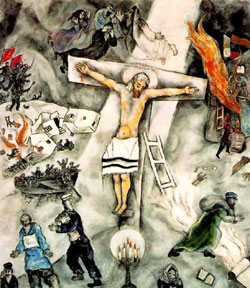One of the reasons that I began to appreciate great art was that, like most other kids, I went through the torture of six years of arts and crafts during elementary school. And it was torture for me in some sense, since I lacked (and continue to lack) all of the necessary skills for success in such endeavors. Facing the reality that even my stick people looked hideously deformed, I soon gained quite an appreciation for the technical skills of a true artist.
However, I’ve recently realized that I have another artistic shortcoming that is a little more serious. Namely, I know almost nothing about art. Shamefully, I managed to make it all the way to Yale without realizing the ways in which art is connected to the realm of ideas, let alone contemplating the relationship between art, beauty, and truth in detail. As a consequence, my capacity for critiquing and commenting on art is pretty limited. Intellectually, I am a neophyte when it comes to art – the equivalent of the little kid in the gallery glancing at a Monet, juice box in hand, screaming “Mommy! Look at the pretty colors!” So don’t say I never warned you.
Anyway, a combination of yesterday’s Google logo celebrating what would be the 121st birthday of Marc Chagall and some great “Jews for Jesus” literature I was handed on my walk home from work today reminded me of Chagall’s White Crucifixion.

Besides the fact that it hangs only three blocks from my apartment at the Art Institute of Chicago and is viewable for free from 5-9 on Thursdays and Fridays, this painting stands out to me for a couple of reasons.
The work of course depicts the horrors the Nazis perpetrated against the Jews. But interestingly, it was completed in 1938, before many of the worst events of the Holocaust had taken place. Such knowledge makes the already haunting images of the burning synagogue, destroyed homes, and wailing ancestral spirits all the more foreboding.
The use of the crucifixion by Chagall, a Jew, is also striking. When viewed in person, the deathly pale tone of Jesus’ skin and the effect created by the blood stains, which seem to have been lightly misted on, suggest that Christ had little blood left to give by the time he was finally hoisted up. Like the Jewish people caught in the destruction of the Holocaust, Christ was tortured and drained of his vitality even before he gave his life. The Hebrew script above Christ’s head and the prayer shawl he wears make Jesus a part of the scene – a fellow sufferer and a fellow Jew.
And so Chagall, for all his flaws, strikes me as a traditionalist in some sense of the word. Like much modern art, the work is certainly chaotic, but the chaos is used purposefully to convey the emotions of remorse and terror that Chagall experienced while witnessing the upheaval of the Jewish community. And unlike many of the so-called "artists" of the past century, he did not strive to throw off the yoke of his social context. Indeed, Chagall’s Jewish heritage pervades all of his paintings. Judaism provided not only convenient subject matter for Chagall, but gave rise to thought-provoking questions about the tradition he was born into. The brilliance of the piece, then, lies not in any technical skill, but in the way in which the artist, shaken by what must have seemed like the impending doom of his cultural inheritance, was able to produce the same shaking in those who view his art today.
1 comment:
...Which requires a lot of technical skill. Chagall's a funny duck, because while much of his art is blatantly political, it also falls in the genre of "fantasty painting," making it at once more striking and further from reality. I believe he also really loved Jesus as an icon, both because he appreciated the power of the Christian mythology for its own sake, and because he knew his audience.
Post a Comment